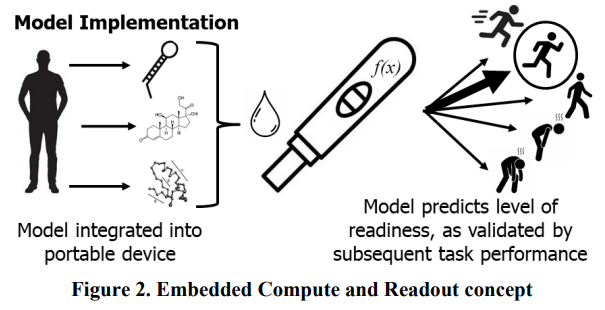DARPA is looking to develop a portable device that will analyze bodily fluids to measure whether someone is physically and cognitively ready to perform their duties.
The Defense Advanced Research Projects Agency (DARPA) is looking “to develop a portable, fieldable, noninvasive device to assess warfighter physiological states, focusing on those associated with physical and cognitive readiness,” according to the program announcement.
“SNAP is focused on a single technical area: to develop a portable device that can predict warfighter readiness through sensing and assessment of molecular biomarkers from an individual’s bodily fluids” — DARPA SNAP program

“The ideal final prototype is intended to be a salivary assay, smaller than a typical cell phone, which objectively measures warfighter readiness for militarily relevant tasks in less than 30 minutes” — DARPA SNAP program
Through the Smart Non invasive Assays of Physiology (SNAP) program, the Pentagon’s research funding arm wants a “device that can quickly quantify, at point-of-person, the variety of molecular biomarkers necessary to predict task performance across a wide range of warfighter roles.”
Those biomarkers, such as nucleic acids, proteins, hormones, and metabolites, will come from biofluids.
While saliva is the preferred bodily fluid of choice for the device to analyze, DARPA says that “other biofluids will be considered, though a strong case must be presented to support biofluids other than saliva.”
“The ideal final prototype is intended to be a salivary assay, smaller than a typical cell phone, which objectively measures warfighter readiness for militarily relevant tasks in less than 30 minutes.”
“Other biofluids will be considered, though a strong case must be presented to support biofluids other than saliva” — DARPA SNAP program

Taking the lead on SNAP is DARPA program manager Dr. Gopal Sarma, who had previously led strategy and operations for the Machine Learning for Health initiative at the Broad Institute of MIT and Harvard.
On the program description, Dr. Gopal said that the technology coming out of the SNAP program could one day “have a transformative impact on civilian medicine, public health, and national security.”

“Our plan is that the technologies generated will have a transformative impact on civilian medicine, public health, and national” — Dr. Gopal Sarma, SNAP program manager, DARPA
“Portable, multi-plexed, multi-omic measurement technologies have the potential to enable ongoing monitoring of health and disease outside of traditional care delivery settings,” said Dr. Gopal.
“While SNAP is focused on DoD applications in warfighter readiness, our plan is that the technologies generated will have a transformative impact on civilian medicine, public health, and national security,” he added.
Dr. Gopal also headed DARPA’s Next-Generation Nonsurgical Neurotechnology (N3) program, which focuses on brain-computer interfaces, as well as the Electrical Prescriptions (ElectRx) program, which focuses on delivering “non-pharmacological treatments for pain, general inflammation, post-traumatic stress, severe anxiety, and trauma.”
For the SNAP program, the Pentagon’s research funding arm is looking to develop a device with six key attributes:
- Be rugged, fieldable, and easy to use
- Uses noninvasive or minimally invasive sample collection of bio-fluids (e.g., saliva)
- Encompass all analytical steps from sample preparation to readout
- Return operationally useful information in operationally useful timeframes (<30 minutes)
- Have very low size, weight, and power (SWaP) (<200 cm2 , <150g, and internally powered) requirements in order to have little to no impact on warfighter logistical burden
- Have analytical capabilities that are adaptable to different physiological states in the context of the warfighter’s specific role(s)
Additionally, “SNAP devices will be readily configurable to diverse DoD end-user needs for readiness assessment, and training, thereby providing an individualized view into warfighter performance state relative to that individual’s peak.”
In the context of the SNAP program, DARPA defines readiness as “a prediction of an individual warfighter’s performance, relative to their peak, in one or more tasks associated with their military role.”
Basically, the Pentagon wants to measure how mentally and physically prepared a soldier is before going out on the battlefield or performing other aspects of their duties.
“The Smart Noninvasive Assays of Physiology (SNAP) program aims to develop a portable, fieldable, noninvasive device to assess warfighter physiological states, focusing on those associated with physical and cognitive readiness” — DARPA SNAP program
Measuring cognitive readiness would be particularly useful for drone operators, while measuring physical readiness would help with soldiers “traversing long stretches of rough terrain while hauling a 50kg rucksack.”
SNAP is a 48-month program divided into three phases: 24 months to develop molecular sensors and associated models for predicting performance in a physical task, 18 months to develop the same for a cognitive task, and six months to refine a fully integrated device for predicting performance on tasks with mixed/combined cognitive and physical characteristics.
If ever made commercially available, what sort of impact would this technology have on the private sector?
What would you think if this type of readiness test were used to measure your employability for a job?












